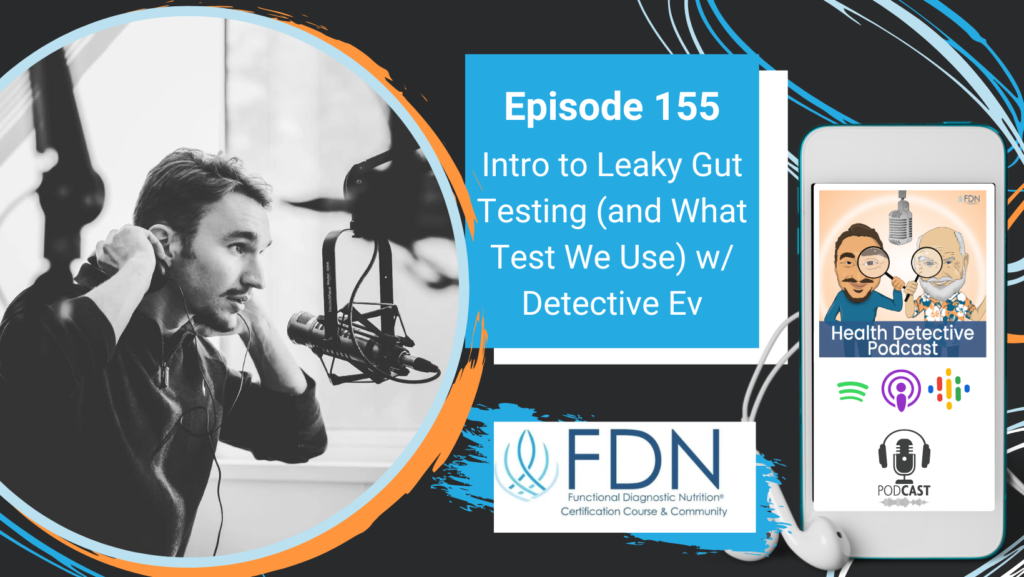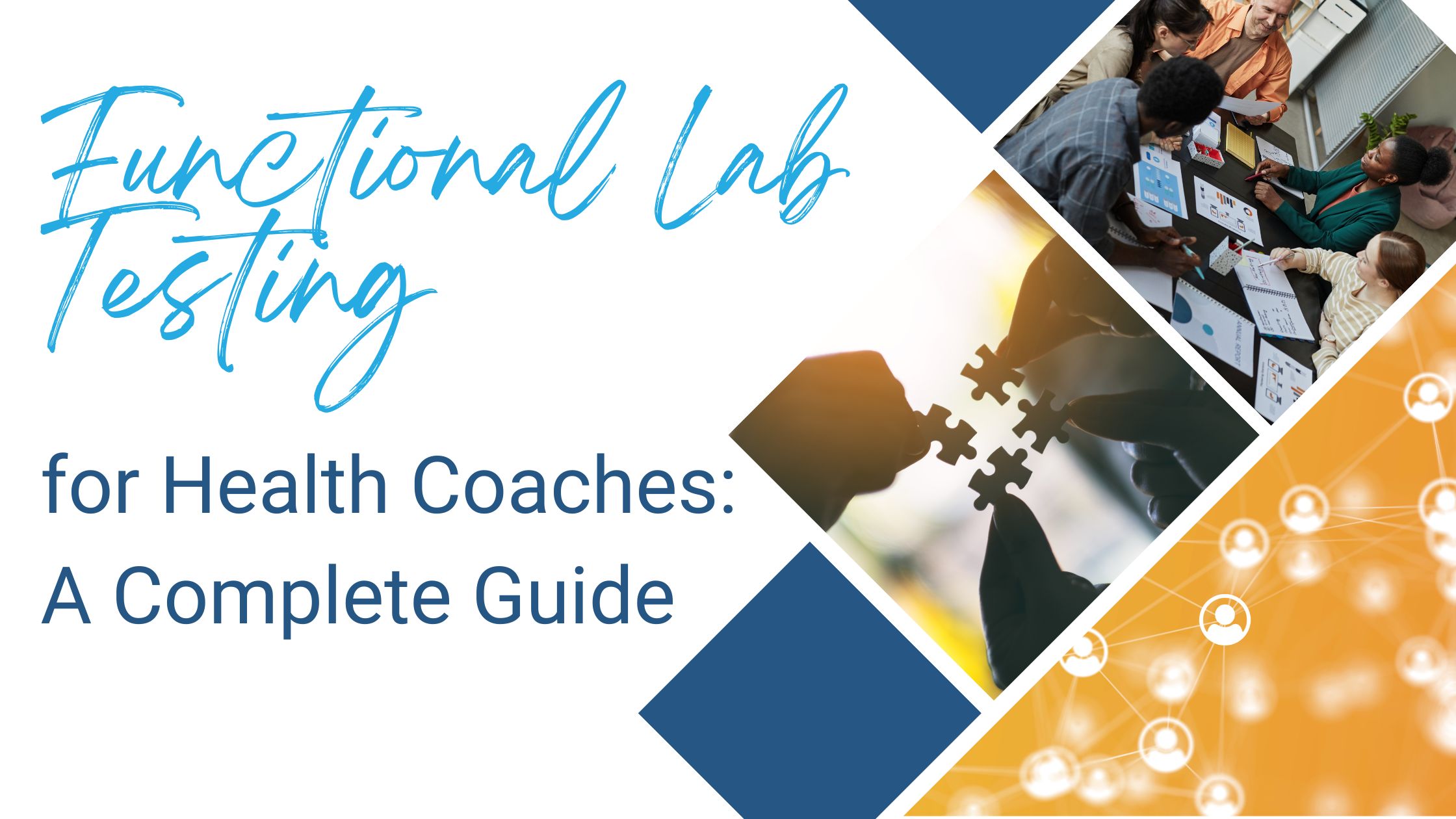Introduction
[00:00:00] Detective Ev: Well, hello, my friends. Welcome back to another episode of the Health Detective Podcast by Functional Diagnostic Nutrition. My name is Evan Transue, AKA Detective Ev. I will be your host for today’s show focusing on leaky gut testing. I’m continuing my solo series, where I talk about the individual lab tests that we utilize in the FDN certification program. The things that you will be trained in, in learning how to analyze and actually make use of for your clients if you are to pursue the FDN course.
I had spread these out a little bit more than I wanted to. We have so many great interviews that I always wanna prioritize those people, but I feel like now’s the time we gotta make sure we get through all these solo episodes and really show people what we’re doing here. You can expect for these to be wrapped up in the next 20 to 30 days or so as I mix them in with other interviews.

Today, we are gonna be talking about the Mucosal Barrier Assessment that we use by Fluids IQ. We really love these guys. FDN is, something you need to understand, it’s a philosophy. It’s a philosophy first and foremost, and it’s a philosophy that focuses on lifestyle modification more than anything else.
Reed always says you can lose all the tests that we have. We could lose all the labs tomorrow and you would still be able to be a successful FDN. Now I don’t want to underplay this either. Of course, our entire certification program is based around, primarily, these lab tests and how to create customized lifestyle programs for people based on the results that they get. So, don’t let me underplay that either.
The Body’s Innate Healing Ability
But at the end of the day, we believe that there is a vital reserve in the body of sorts and an innate healing ability. You don’t really have to believe in either of these options per se. We can all tell that a 10-year-old, generally speaking, is more vital than a 100-year-old. Even the sickest 10-year-old versus the most healthy 100-year-old will still have some types of energetic differences. Maybe on the far end of those extremes that wouldn’t be a fair comparison.
[00:01:55] Detective Ev: But generally speaking, there’s just something that kids have that we don’t have as we get a little older. So that’s that kind of vital reserve.
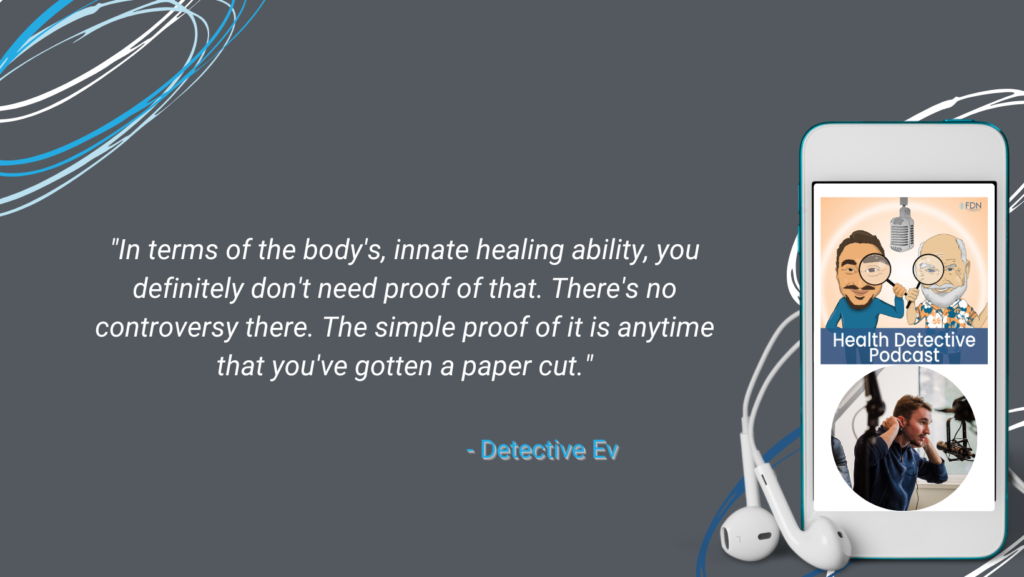
In terms of the body’s, innate healing ability, you definitely don’t need proof of that. There’s no controversy there. The simple proof of it is anytime that you’ve gotten a paper cut. You slice your finger by mistake with the paper, it hurts. Not too bad, but it hurts a little bit. Starts bleeding and you don’t really have to do anything.
You don’t have to go get stitches or do anything crazy with it. You stop the bleeding, you put some pressure on it, which, yes, we might do with a paper towel or something in today’s world. But even in the wild, long before there was paper, if they got cut on something, you know, maybe they stopped the pressure a little bit and stopped the flow.
Some of the Fastest Regenerating Cells in Our Body
The rest of the other things that heal that is up to the body. You didn’t have to think about it. You didn’t have to tell it to do anything. You didn’t have to give it instructions or write out a long list of things for it to read. It doesn’t work like that. It automatically knew that we need to repair this. It’s kind of amazing.
Now, that’s one of the most simplistic ways that we can break down that innate healing ability is that paper cut example. On a much larger level, we can see this same thing with our organ systems and any part of our body in general. But now we’re talking about a larger stress than just some sharp-edged paper being rubbed against our finger.
That’s a pretty easy problem to solve. Stop rubbing sharp edged paper against your finger, and you won’t have the stress anymore. We’ll call that the stress that’s leading to that damage. Now, let’s take our gut function for example, or the integrity of our mucosal barrier, which is what we’re gonna be talking about today. That can heal.

It’s actually some of the fastest regenerating cells in the body. To be specific, the epithelial cell layers in our intestines are some of the fastest regenerating cells in our body. They turn over every few days. That’s pretty amazing that it can do that. Some cells are way, way longer than that for a full turnover.
Stress of All Kinds Can Lead to Leaky Gut
Here’s the problem though, just like the finger, if it got exposed to a sharp-edged piece of paper and it got cut, the gut is also subject to be attacked or damaged or stressed out. We all know that probably even if you’re not in FDN yet, or even in the functional space at all. Most people I have found have heard the term leaky gut at this point. Not everyone of course, but the vast majority of people have. They might not be able to explain it, but they’ve heard of it at least.
[00:04:25] Detective Ev: Here’s the thing though. This isn’t like the paper cut where the stressor is always so obvious or it’s just one thing. Where, again, it would be the paper in this case. You might have pathogens, you might have food sensitivities, you might have environmental stress from toxins, stuff in the environment, glyphosate.
Glyphosate is in our rain now. I don’t mean to scare anyone, but I mean, it’s crazy how involved this stuff is in our environment. You really can’t avoid it, even if you’re doing the best that you possibly can. It’s not to suggest we don’t wanna mitigate it, but we can’t really reduce it to the point of it not being existent, as far as I know. Unless we’re living on some really, really remote areas of the United States, Canada, or other parts around the world.
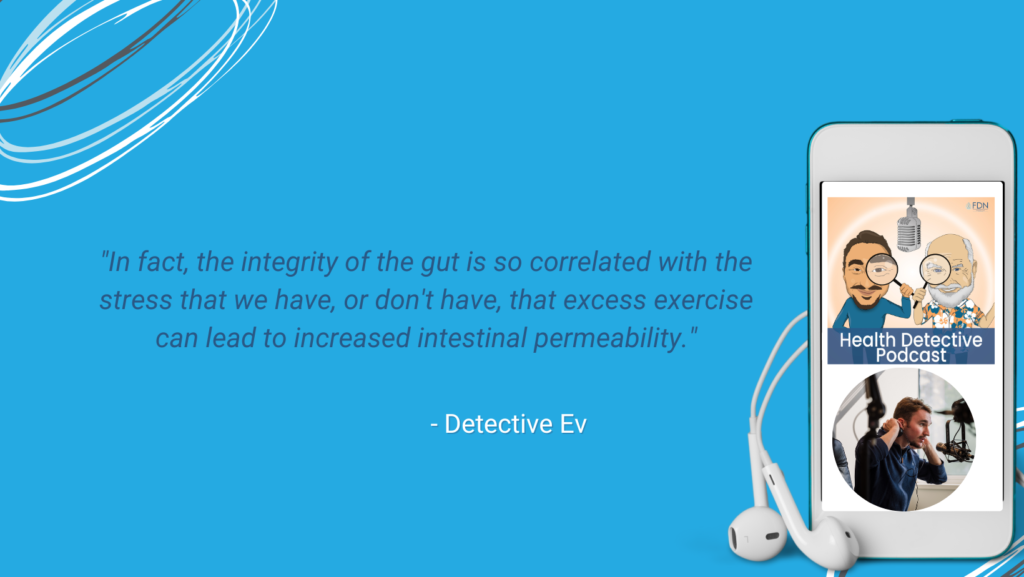
I don’t know how we would avoid that completely. I think that’d be pretty darn hard. Even emotional stress has been shown to lead to a leaky gut. In fact, the integrity of the gut is so correlated with the stress that we have, or don’t have, that excess exercise can lead to increased intestinal permeability.
Identify and Remove Stressors to Heal Leaky Gut

Pretty crazy. Right? So that’s not a bad thing necessarily, as long as we know what to do. But my point is, just like the finger can heal, the gut can heal too. But if we can’t identify and remove what’s actually happening there, that’s a problem.
Now, one of the main ways we do that is actually with the other tests that we’ve mentioned so far. The food sensitivity test is gonna be a great one. The gut test, not to be confused with the Mucosal Barrier Assessment, which we’re talking about today. The gut test, which if you wanna listen to that one, by the way, go to the link in the show notes of this episode. Anywhere that you’re listening, just check out the description of the podcast and you will see it at the bottom. I have it listed out and you can click it directly.
That gut test is gonna look for the GI pathogens, whether it’s bacteria, parasites, overgrowth of fungi, yeast, et cetera. It’s gonna look at digestive function. Which we can indirectly look at on this test that we’re about to mention. But we can look at it in a more direct sense on the GI MAP, which is the gut test that we use based on digestive enzymes and the pathogens that we have. Some of those like to make it not so easy to break down our food.
A lot of things that can cause the stress. A lot of things that we have to look at to make sure it’s getting removed. But we also need to be able to measure just how affected one’s gut has been.
The Stress Tolerance Seesaw
It can heal. We have that innate healing ability, that’s my whole point. But we have to allow it the playing field to actually activate that healing. If we are getting a constant bombardment of stress, we can’t win. In a very overly simplified fashion, you can almost think of this as a seesaw. The body can handle stress. That’s how human beings got to where they are today.
If you haven’t realized we’re actually quite fragile animals, even our ancestors that would’ve lived more in the wild were really subject to a lot of things. There’s insects that can kill us, snakes could bite us, other big animals could take us down. We’re really only powerful in numbers in that sense.
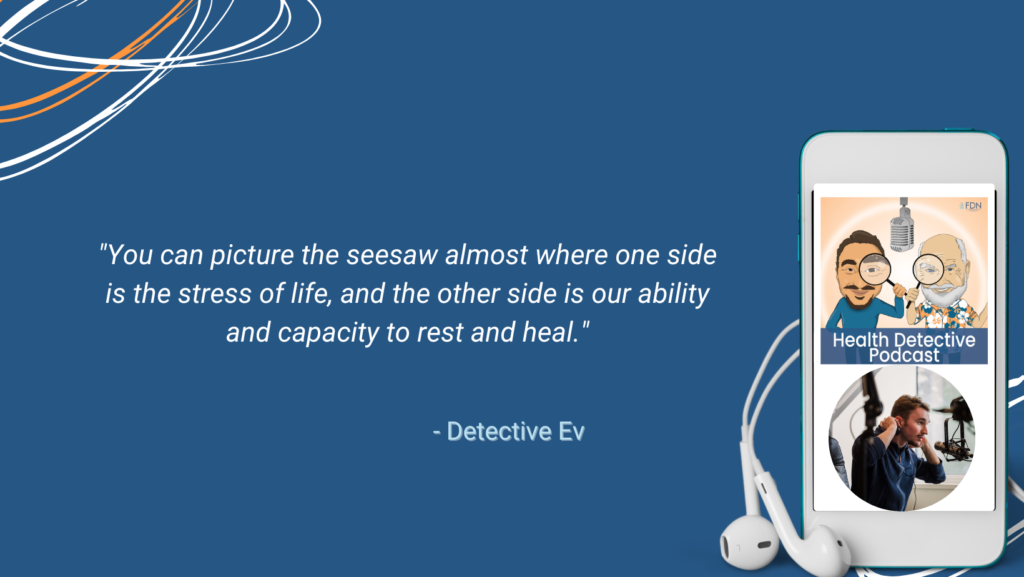
But the other thing that we have is we do have a good ability for stress tolerance. It’s more than the average person realizes. You can picture the seesaw almost where one side is the stress of life, and the other side is our ability and capacity to rest and heal.
[00:07:45] Detective Ev: The person that maybe meditates for a couple hours, every single day. I’m not saying you have to do that, I’m just saying, for example. The person who gets eight hours of sleep, the person who maybe uses something like a float tank, otherwise known as a sensory deprivation tank, where they really get into that parasympathetic mode. They might be able to handle more weight if you will, on the other end of the seesaw because their rest and digestibility, the rest and healing ability is strong. There’s a lot of weight on that side.
Why Leaky Gut Can Get Leakier
Similarly, if someone had too much weight on the opposite side of this seesaw and they get six hours of sleep, they never meditate, they’re constantly going every single minute of the day, they never take a deep breath at all.
[00:08:31] Detective Ev: Then on the other side, they have crappy foods that they’re eating, they have fights with their families all the time. They are really obsessed with exercise, which of course we want people to be healthy and exercise, but if you’re in a stressed-out mode, in a sick mode, working out six, seven days a week, hour plus each time, you might find that that’s actually not useful for yourself or your clients.
We’ll train you about that more in the course. I thought that was very counterintuitive when I first heard it. It turned out, ironically, I was one of those people that needed to tone down the exercise temporarily because this was affecting me as well.

But that’s not the point. My point is these are all things that can be on the other side of that seesaw, where, if there’s too much of it, now we’re really seeing the gut get leakier and leakier, and we’re seeing the problems that can happen there.
That’s why we have a Mucosal Barrier Assessment. We do use this again by a company called Fluids IQ, and we test a few markers on here. I think this is a really powerful test because what it allows people to do is actually quantify, to some degree, how leaky their gut may be.
FDNs Are Well-Trained Concerning Leaky Gut
Now, even though the technology continues to get more and more advanced, I wouldn’t necessarily say that there’s a perfect test right now for leaky gut or intestinal permeability. But we’re doing pretty good with the markers that we have. And FDN, in the most unbiased fashion I could possibly say it in, I think we’re some of the best in being trained with this.
I know this because most naturopathic doctors, half the time, can’t even truly explain leaky gut and what’s going on. At least we can explain it and then we offer the testing on top of it. Just like all of these episodes, I am really trying to just scale back and give a 30,000-foot view, as opposed to all the details.
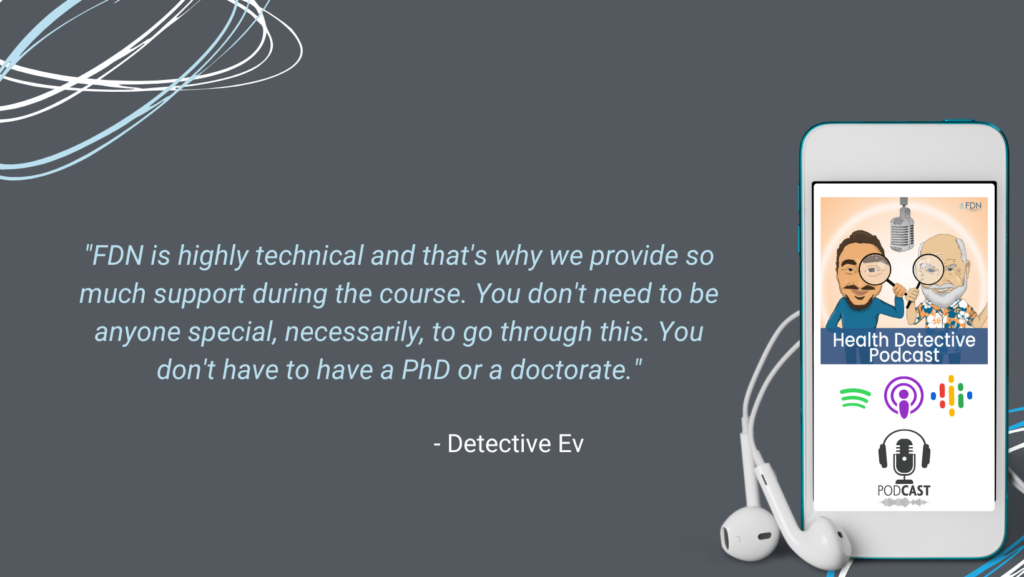
FDN is highly technical and that’s why we provide so much support during the course. You don’t need to be anyone special, necessarily, to go through this. You don’t have to have a PhD or a doctorate. I had none of those things. I had no relevant health degrees when I went through the FDN course. I had a willingness to learn and study and work my butt off, but you don’t need any of that other stuff.
So, I’m underplaying what we do today just to keep it simple and straightforward, because I know everyone listening might be at a different level. But it’s important for me that you understand what is really going on here and what we’re gonna be looking at in these tests. You can at least look it up more if you’re interested in that.
A Mucosal Barrier Visual – Epithelial Cells
One of the main markers that we’re looking at on this test is something called zonulin. Zonulin is a protein found in intestinal cells. Production of it kind of mimics the effect of certain bacterial toxins on the tight junctions of the small intestines.
What does that mean? I claimed that FDN is some of the best trained people in leaky gut, especially when it comes to explaining it and actually helping it resolve for people. But what is a leaky gut? We’re mostly referring to the intestinal lining when we talk about this. We’re certainly referring to this when we’re using this test for the Mucosal Barrier Assessment. You could just actually call it an intestinal Mucosal Barrier Assessment.
You have these epithelial cells, the outermost cell layer. And if you want a visual of this, a good one is on Google. You could look up, Dr. Josh Axe, leaky gut.
You should be seeing the epithelial cells. And how you’ll know you’re looking at that is the chart kind of has these little blobs with these hair-like things at the top. And then there’s pink circles in the middle of each.
On the far left, you’ll see tight junctions. What those are is, ideally what they’re supposed to be, nice, sealed cells. This is not how a gut would actually look, by the way. If one of them was severely damaged as they are on the right side of this document, the left side would also be pretty bad too. But it’s trying to paint a picture here.
The Progression of Leaky Gut
The left side is what a healthier gut would look like. You can see that these cells are nice and sealed. All those toxins, microorganisms, things like gluten, they can’t really get through so easily and it doesn’t get to the blood as a result.
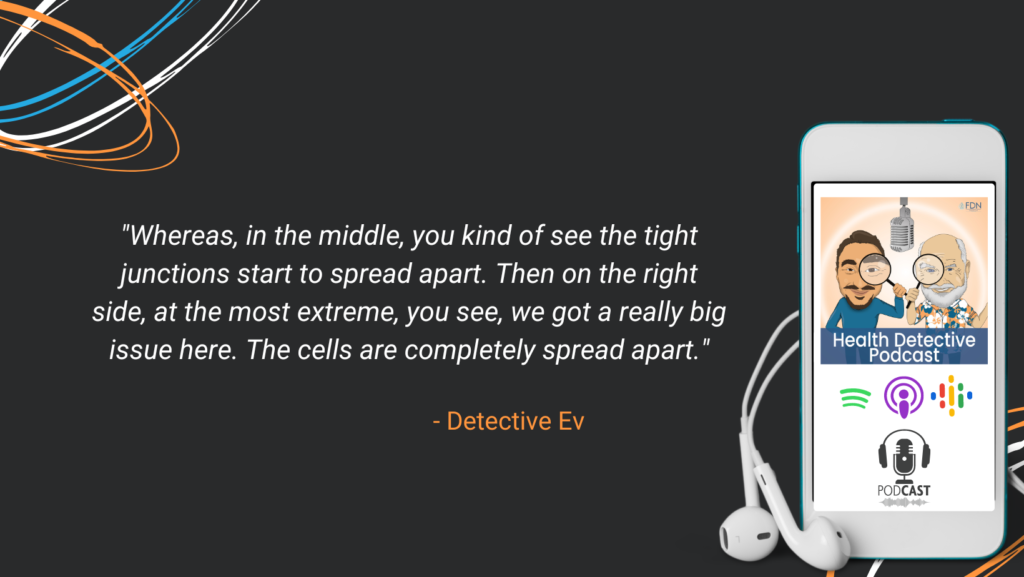
Whereas, in the middle, you kind of see the tight junctions start to spread apart. Then on the right side, at the most extreme, you see, we got a really big issue here. The cells are completely spread apart. It wouldn’t necessarily be this dramatic, but the point is now things that shouldn’t be able to get into the bloodstream are getting in.
Mind you, this is all still on a microscopic level, let’s be clear. You’re not getting multiple inches of food particles flying through your gut, that would be a very large problem. But you’re getting stuff that’s much larger than nature intended. When this happens, this stuff’s going right through, it gets into that bloodstream, and now you are subject to how the body reacts to that.
When it sees something that’s not supposed to be in its bloodstream in its bloodstream, it usually is gonna react with an immune response. This is how a lot of people can get autoimmune conditions. Certainly, this is food intolerances by definition.
This is why food intolerances can heal, it’s one of the reasons. You could calm the immune response, but you could also stop the problem. If, for example, I’m sensitive to something that should be relatively healthy, let’s take like avocados for example. My gut’s leaky and now some of that avocado protein, it’s not digesting properly, first of all. Now, I have these tight junctions are leaky, just to be specific here and clear on my language.
How a Food Intolerance Can Be Born

Well, now those avocado proteins, as they’re flying through the digestive system, all of a sudden can get through those cells and into the bloodstream. And your body, since this thinks it’s a foreign invader, it has nothing to worry about. Right? It’s just avocado. But it thinks it’s something that shouldn’t be there. So, it reacts with an immune response and now you have a food intolerance. Now, every time you eat that food, you have a stress response.
This is why leaky gut, although it’s seemingly so easy to get control of because you’re thinking, well, this is some of the fastest regenerating cells in the body. Shouldn’t this be easy? It’s like, sure. But at the same time, we have more assault on this stuff than ever before. It’s almost a self-fulfilling prophecy.
It’s more of a vicious cycle. But it’s self-fulfilling in the sense that stress can cause a leaky gut, but a leaky gut can cause more stress by creating food intolerances, nutrient malabsorption, as you see on the bottom there, just inflammation in general, which are all things that can further worsen the leaky gut.
Are you kind of understanding, even if you haven’t listened to the other episode yet, why we use a system of labs as opposed to just a few? We need to see where the assault is coming from. We need to know what kind of gut pathogens this person has. Can they even digest the healthy food that they’re eating now?
Because they’re working with FDNs, you’d hope they’re eating healthy food. We need to look at this stuff. So, that’s what we’re talking about when we talk about leaky gut. I hope that document and chart is helpful.
High Zonulin Implies Worse Leaky Gut
Now, I want to go back to the zonulin and break this down, and why this matters. So, we talked about this, it said it’s mimicking the effect of certain bacterial toxins on the tight junctions of the small intestine.
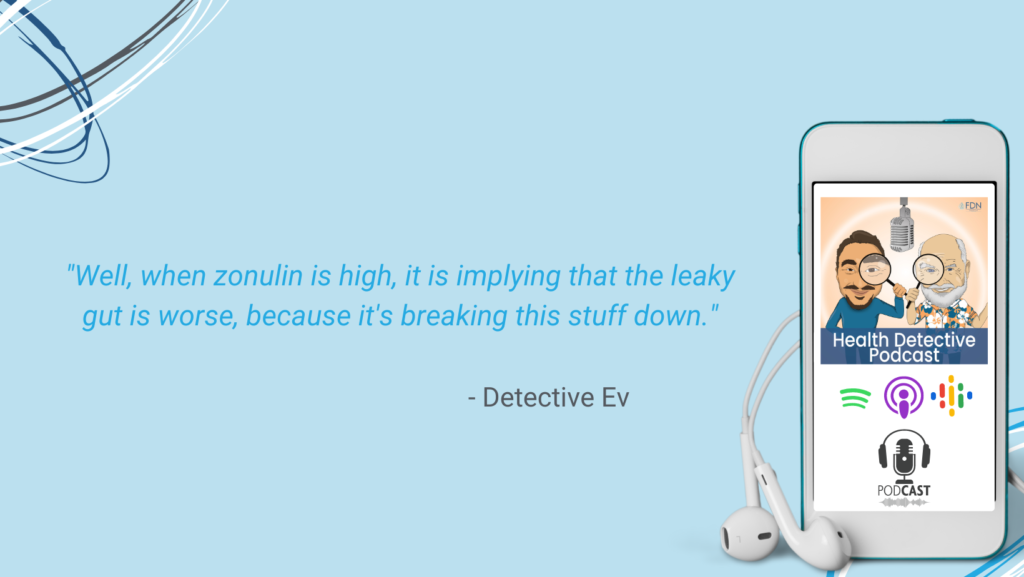
What is the implication of that? Well, when zonulin is high, it is implying that the leaky gut is worse, because it’s breaking this stuff down. Then when the gut has increased permeability past the point of being normal, because there’s always some level of permeability in the gut, that’s why that chart is useful, but it’s a little misleading, right?
We wouldn’t necessarily see it so extreme on the right side, not necessarily and hopefully not. And on the left side, you wouldn’t see what appears to be a perfectly tight junction. There’s always gonna be some level of permeability when we’re talking about intestinal permeability that’s subclinical. I don’t think there’s a clinical diagnosis yet for intestinal permeability, otherwise known as leaky gut.
We’re talking about permeability that is passed the point of being normal and now has very clinical aspects where this person is sick. There’s a clinical result for them having this leaky gut.
So, intestinal permeability changes due to zonulin have been implicated in many diseases. Go figure. Notably, celiac disease and type one diabetes have been some of the worst, but also in others, including the brain, respiratory system, and skin. For someone like myself who has dealt with cystic acne, I pretty much consider leaky gut par for the course when we have skin stuff. This just shows how much it can fluctuate.
Heal and Seal Leaky Gut Quickly
There’s been times in my life where I’ve been under such low stress now, even despite having been on 20 courses of antibiotics, eating gluten my whole life, high amounts of sugar, really destroying my body, I was able to get my skin clear completely.
Then other times, ironically, right now (it’s nothing bad, thankfully), but I’ll have little breakouts just from what’s going on. Crazy work schedule, not through FDN’s fault, just other stuff that I do outside of this, to be clear. Then maybe, you know, traveling a lot, eating on the road and in the car, I’m guilty of this. This is like my worst habit is eating in the car while driving because I have so much stuff going on. Not good. So, I’ll get a little breakout.
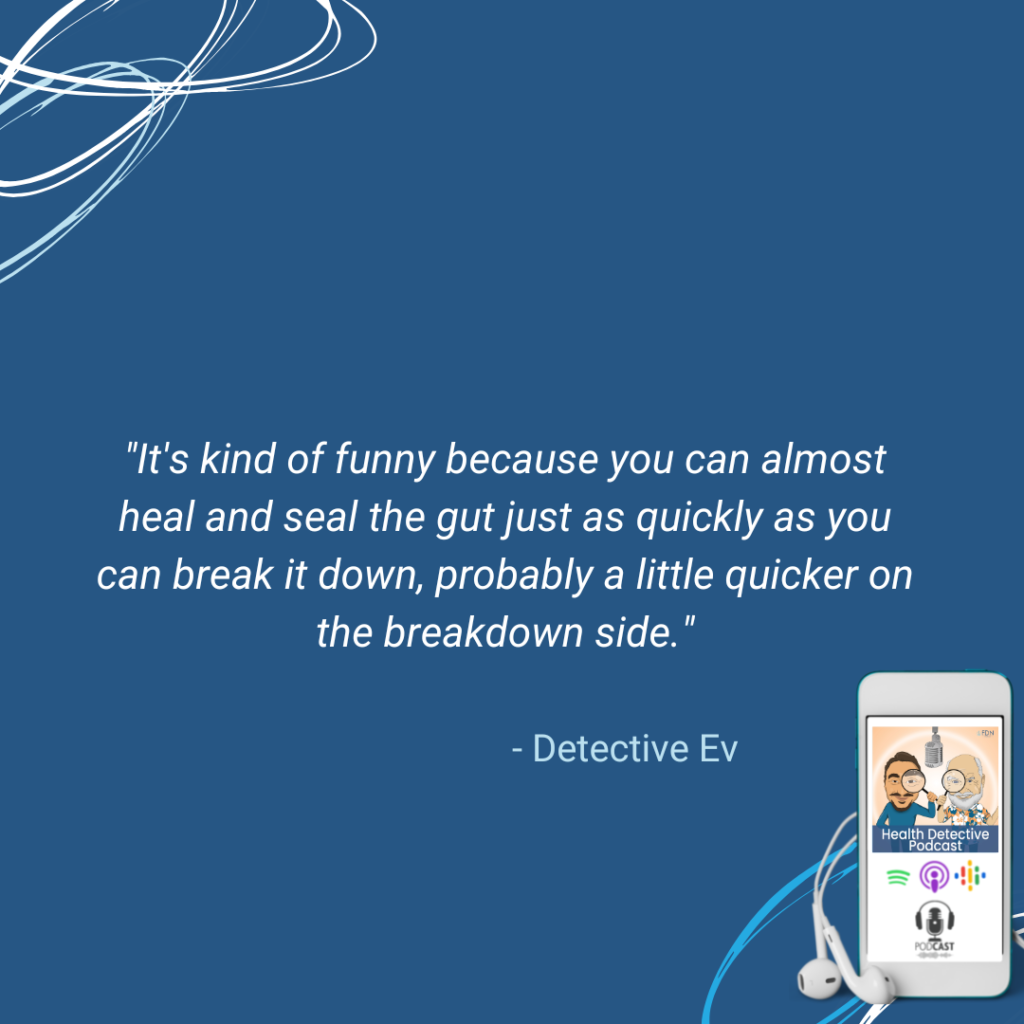
It’s kind of funny because you can almost heal and seal the gut just as quickly as you can break it down, probably a little quicker on the breakdown side. But it’s very fast how far you can go on either end of this.
It gives me a sign and an indication for my body that it’s time to slow down, it’s time to chill out, time to utilize that seesaw that we mentioned in the beginning. I need to put more on the side of the rest and recovery type of thing.
So, we’re gonna look at zonulin. That’s one of the main markers to help this get figured out. Another thing we’re gonna look for is histamine on here. This could be a really good thing for people to check because you have a lot of clients that are exhibiting histamine type symptoms and high levels of histamine.
Histamine Excess Triggers
Just to break some of them down, runny nose, sneezing, congestion, itching, hives, skin flushing, dizziness, or vertigo. (Really interesting, cause I had that at one point. I had Meniere’s disease at 18 years old.) Headaches or migraines, nausea, vomiting, intestinal cramps, or gas, diarrhea, abnormal menstrual cycles, shortness of breath, abnormal heart rate, high blood pressure, severe allergic reaction.
So, minus the severe allergic reaction and high blood pressure, I pretty much had all of this as a kid. Well, okay, sorry. Other than the abnormal menstrual cycle as well, I promise I didn’t have that. But the other stuff I had. It’s kind of funny, cause looking back, did anyone ever talk to me about testing histamine or even mentioning the word histamine? No.
Again, just the 30,000-foot overview today. What’s the basics of this?
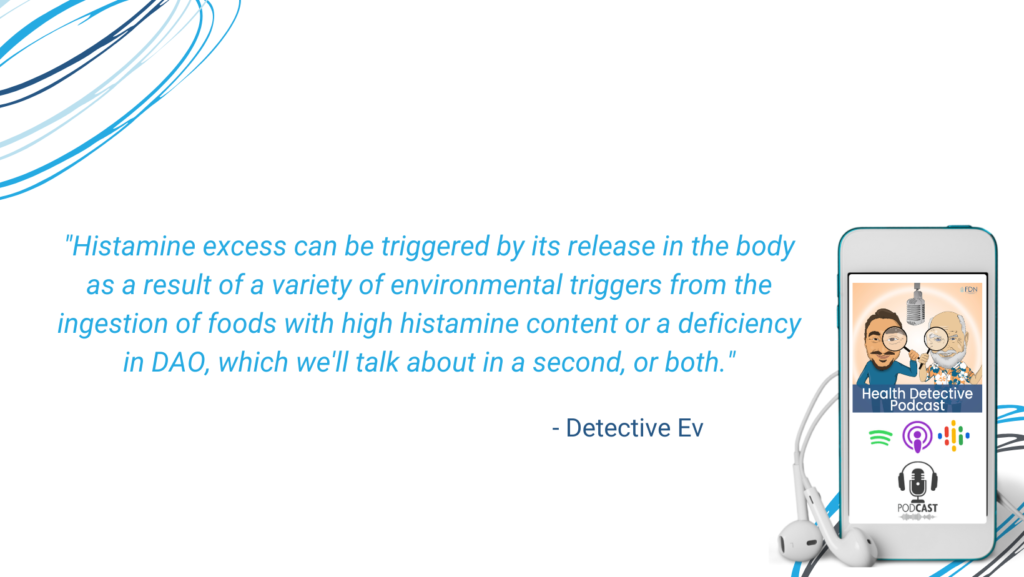
Histamine is involved in many inflammatory and allergic processes, including both immediate and delayed hypersensitivity reactions. Histamine excess can be triggered by its release in the body as a result of a variety of environmental triggers from the ingestion of foods with high histamine content or a deficiency in DAO, which we’ll talk about in a second, or both.
We need to measure this because if the histamine is constantly high, you probably can already guess it, you’re going to have worsening gut function, increased permeability, increased leakiness. Not to mention the person’s gonna be very symptomatic. There’s a few things that we can do to help them during their time of recovery.
We use something called intelligent apathy. Intelligent apathy in our world is just common sense supplementation, common sense lifestyle changes. What can we do maybe on the more strict side temporarily to help the person feel good while they engage in actual healing?
Why We Need a System Like FDN
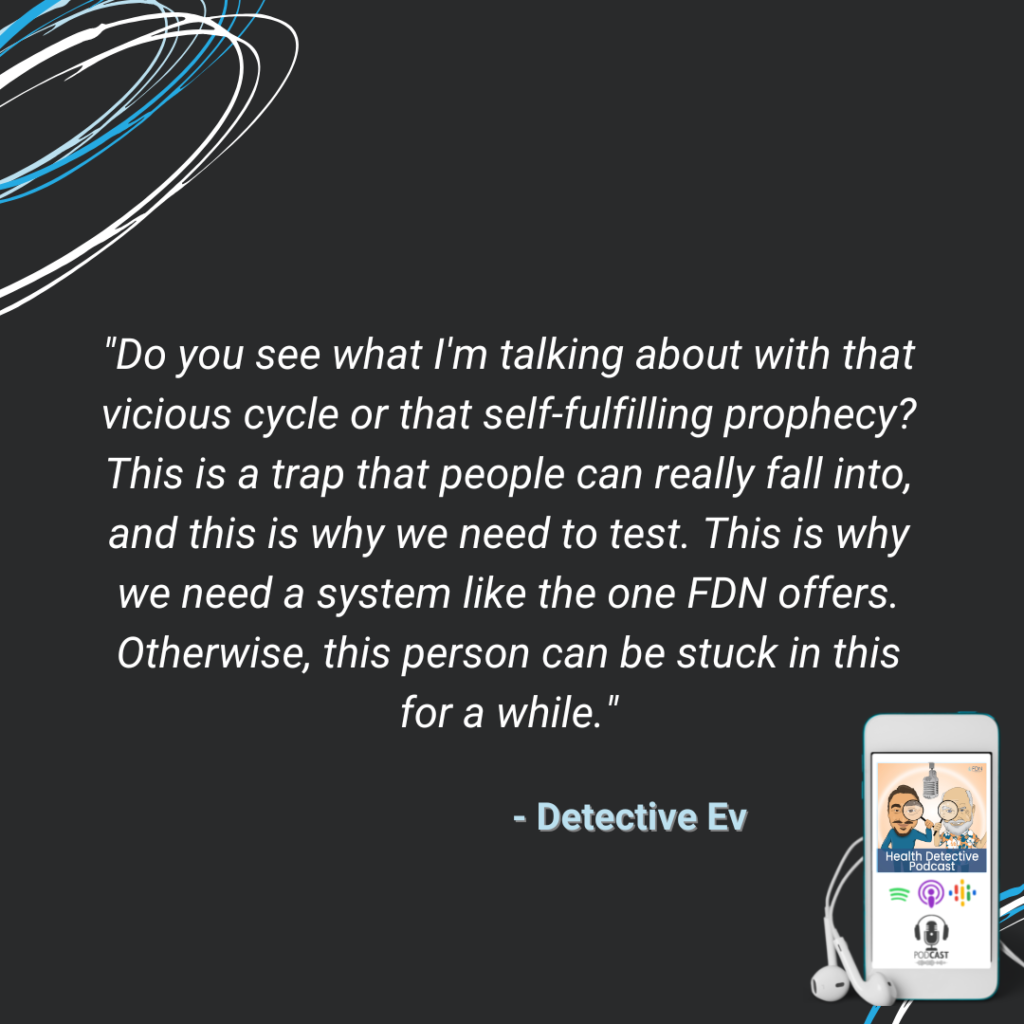
Now, I just wanna mention really quick also what causes some of these high histamine levels. Listen, it’s an extensive list, but just breaking down some of it, gluten tolerances can absolutely do this, gastrointestinal bleeding. Check this one out, intestinal permeability could also cause this. Do you see what I’m talking about with that vicious cycle or that self-fulfilling prophecy? This is a trap that people can really fall into, and this is why we need to test. This is why we need a system like the one FDN offers. Otherwise, this person can be stuck in this for a while.
Certain genetic mutations can do this. We don’t wanna not recognize that. Now, that’s not a death sentence, by any means. There’s plenty of things that we can do to help, but we need to recognize that genetic mutations can do this as well. Inflammatory bowel diseases, such as Crohn’s or ulcerative colitis and certain medications.
Nonsteroidal anti-inflammatory drugs, probably some of the worst. This is your NSAIDs. You might have heard of it listed like that. Ibuprofens, naproxens, aspirins. That’s all gonna be stuff that falls in that category. Antidepressants can do it as well. Immune modulators, antiarrythmics (and this is the funniest one), antihistamines can also lead to this kind of stuff. Things like Benadryl and Allegra. It’s a go figure, right?
Now, by the way, if someone has low levels of histamine, you could see things like fatigue, sleep/wake disorders, depression, and anxiety, in older adults, which is ironic. Because what are we gonna give them if they have depression and anxiety? We’ll throw them on the antidepressant, which could in turn worsen histamine levels. Kind of backwards what we’re doing sometimes. Right?
DAO and Histamine to DAO Ratio
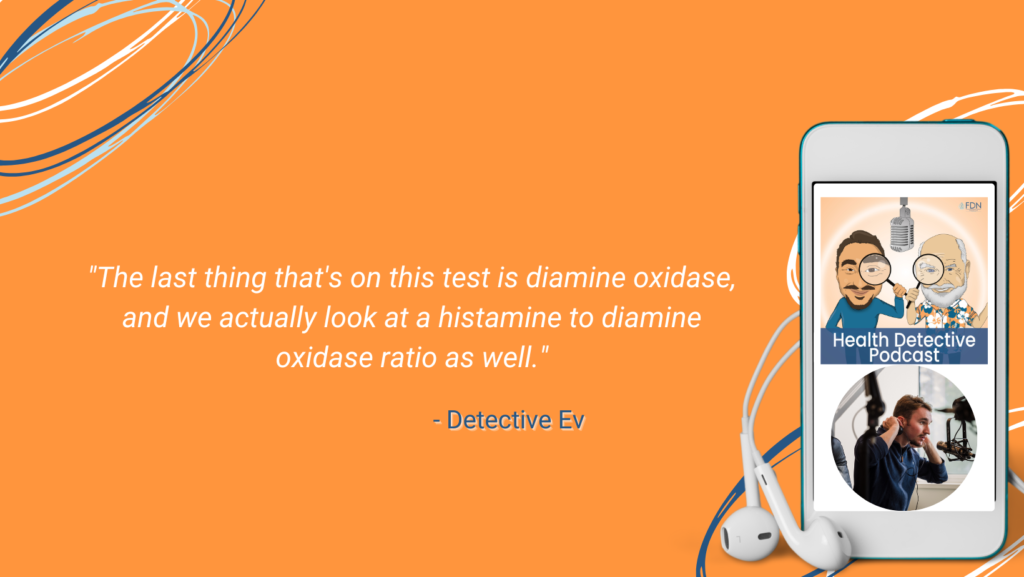
The last thing that’s on this test is diamine oxidase, and we actually look at a histamine to diamine oxidase ratio as well. But in terms of just singular markers, unique markers, a DAO is gonna be the last one. The ingestion of histamine rich food, alcohol, or drugs that release histamine can also block DAO.
Now it’s an enzyme. It’s something that the body naturally produces. It also can be taken as a supplement and we’re not necessarily recommending anyone go out and just randomly take this as a supplement. Certainly, it could be used intelligently, but that’s not what we’re suggesting today. When we have an imbalance between this, it can provoke an accumulated histamine response.
So, you’re kind of adding this up over time, making this worse and worse for people. You’re also losing the capacity for histamine degradation, which is what causes that accumulated issue. We need to look at both of these things. We need to look at something pushing the histamine up all the time.
Similarly, does the person have too low of DAO? This is why the ratio matters. You should automatically pretty much understand that because if the histamine’s too high or the DAOs too low, you have an issue. Even if those numbers are still within a quote/unquote “normal” reference range, if the ratio’s off, you could still see the person with an issue.
So, an impaired histamine degradation based on reduced DAO reactivity, and the resulting histamine excess may cause numerous symptoms mimicking an allergic reaction. Kind of interesting how this stuff can be broken down. This one can get pretty technical.
Signs and Symptoms of Low Levels of DAO
I want to give you just some of the signs and symptoms of low levels of DAO. See if it sounds like you. You could have a skin rash, itching, eczema, psoriasis, nasal congestion, asthma, again, headaches or migraines, chronic fatigue, anxiety, or depression, inflammation, and IBS, estrogen dominance, muscular pain, or fibromyalgia, rheumatoid arthritis, hypertension, hypotension, arrhythmia, multiple sclerosis, and other neurological conditions.
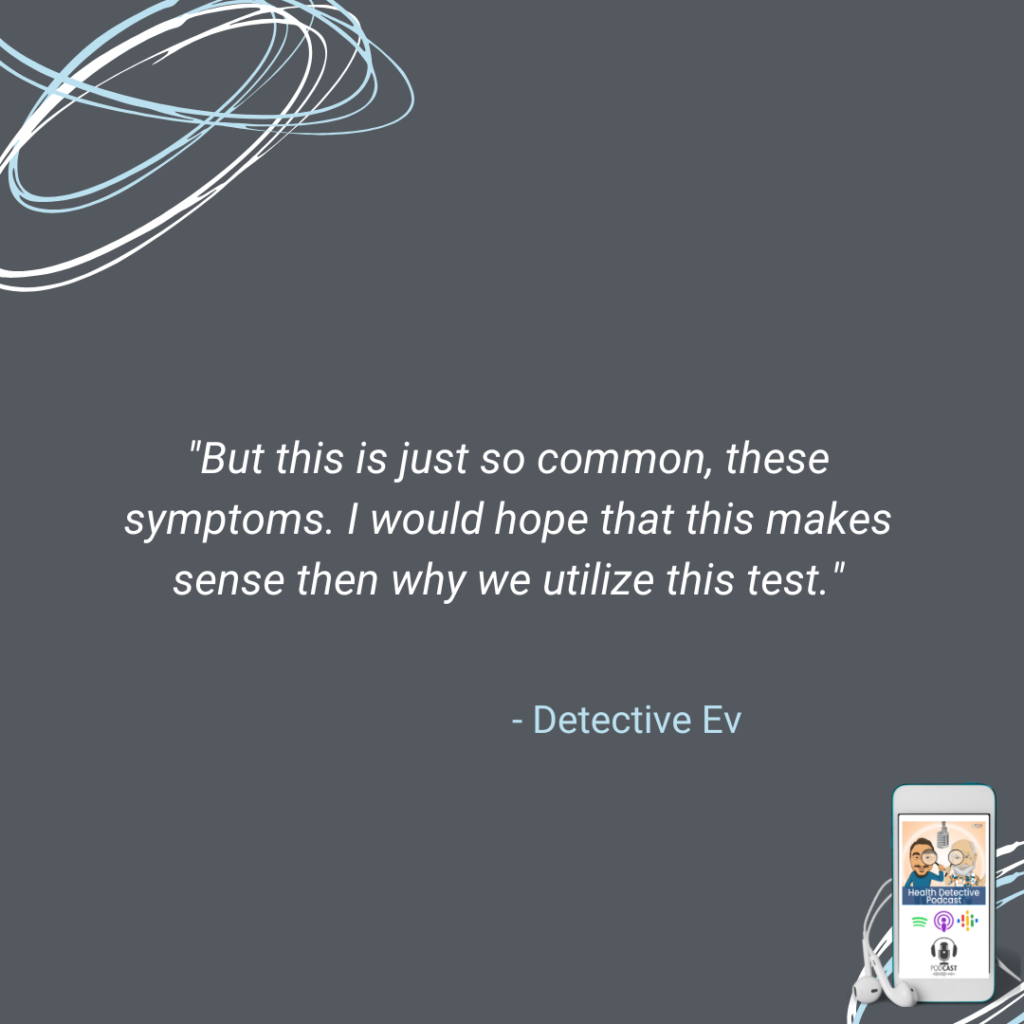
Sound like you or anyone you know? Not that it’s literally funny, right? But this is just so common, these symptoms. I would hope that this makes sense then why we utilize this test. This is about as far as I want to go with this one today, I’d like to keep these solo episodes under 30 minutes.
I’m not trying to bore anyone to death, even though you guys are all fellow nerds, and this probably is not boring you at all. But we also don’t wanna go too complicated. I’m trying to just give you a hint of what this is like. I’m letting you know that we do get pretty technical here. You’re gonna learn your stuff. You’re going to study hard and you’re gonna be a respected practitioner because of this.
[00:24:08] Detective Ev: But today I hope I did a good job of explaining how and why we use this Mucosal Barrier Assessment. It’s a dried blood spot test by the way. So, what that means is you literally just take a little finger prick. This all can be done in the comfort and safety of your own home. It is super simple. Then it can be sent off in the mail. It is very, very easy to do.
Conclusion
I hope with all that said, this was a good explanation. And of course, if you guys have any further questions on this, all you gotta do is go to our Podbean, which is our podcast platform that we host from. You can leave me comments there. Just go to the Health Detective Podcast on Podbean, leave a comment there.
Then of course, if you’re considering the FDN course, go to fdntraining.com/tryfdn and you will actually be able to try the FDN course completely for free, no credit card required. Just get to dive deep, get to see what this is all about and see if this is something for you.
With that said, I will be back next time with another interview. And depending on when you’re listening to this, very good chance that some other solo episodes are either already out or may be just around the corner. Cause again, I wanna make sure the rest of these are out in the next 20 or 30 days or so.
Thank you, guys, so much for listening and I’m looking forward to talking to you guys again soon. You are always welcome to visit us at functionaldiagnosticnutrition.com.

